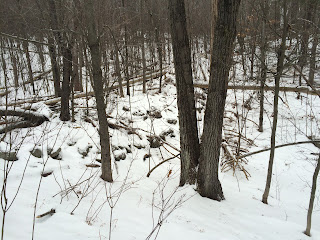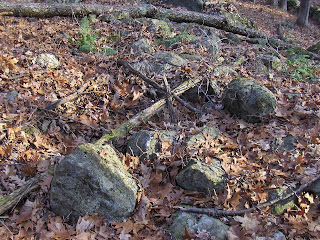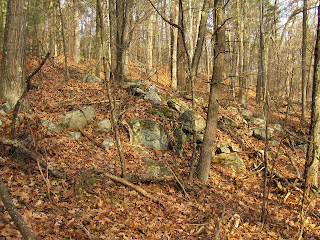In lieu of an annual summary I will post some "fresh" 2017 finds (now seven months old) that I haven't posted here before. As I write this, in the year's very final hours, temperatures outside are in the single digits. Maybe a good time to go and revisit the end of May. These finds were made over a period of three days.
The Site
This is a place in Rhode Island I have written about before, I have many finds from this place. Many people know about it and go look for arrowheads there. Some local collectors I have talked to don't go there anymore, they say it is picked over, nothing left there to find. It's a sandy area by a salt marsh.
Day 1
I like to get out on Fridays after work and search for artifacts. It is a good way to decompress and to start my weekend. A nice walk out in the open helps to clear my head, it's a way to relax for me. We had had a bunch of rain so I drove to this site to see if there was any fresh exposure. Sure enough, lots of bare earth visible from the road, muddy. I expected the place to be a sea of footprints, from other people out looking. To my surprise, there were no footprints to be seen. I immediately went to the most productive area. That's always my strategy, I do the most productive area first. I found this right away.
This is a nice stemmed point. Points like this are variously described as Small Stemmed, Wading River, or Squibnocket Stemmed projectile points. I think the people that made all these quartz arrowheads made a variety of points like this and I'm not convinced of the value of trying to use rigid classifications to type these. A lot of the time they are pretty crudely made and whether the stem is straight or contracting, or whether the base is squared off or curved, may have had less to do with the maker's intentions, than with how the rock broke when it was being chipped. That's just my opinion based on finding these things, all the various types, mixed together on the surface in disturbed contacts but in the same sites (in the same areas of the same sites, in fact) over and over in different places. Anyway, this was a few feet away.I call this a Squibnocket Triangle, and I think this is a very nice example. It is fun to find a nice whole point like this.
This was a beautiful thing that stopped me in my tracks. Still muddy from the rain.
I didn't have that much time to look, less than 2 hours before it became to dark to see. Here is everything I found. There are some broken projectile point fragments as well as a couple of larger pieces with worked edges that I think probably were used as scraping tools, but that could have been blanks or preforms.
The best of the evening's finds. A lucky day. As I walked out, I knew there would be more to find in this place.
Day 2
I had no free time on Saturday- so I thought. But towards the evening, with the sun going down, it looked like I might have just a little bit of time and could squeeze in one hour of looking. Again, I expected footprints. But nobody else had been there. Here is one absolutely anybody would have spotted.
Can you believe it? This is one of the nicest stemmed points I have ever found at this site.It's unusual to find a point of that size that is not broken. On this evening, within an hour, I found two. This one is argillite. Argillite always feels soft to me and I marvel that the Native Americans made usable tools from this. I recently read an archaeological report in which argillite tools were recovered from cremation burials approximately 2,000 years old. When the tools were unearthed, they were very soft, but became hard upon exposure to air.
I would estimate that more than 95 percent of the chipping debris, tools and fragments of tools that I find here is quartz, most of the rest is argillite. But I have very few intact argillite projectile points from this site.
These arrowheads are very similar. I find few like this, then two in one outing.
Day 3
On Sunday I had more time to finish up, and I was not disappointed. This is sort of an unusual shape.
This stemmed quartz arrowhead was easy to spot. Rather crudely made, possibly reworked from something larger. Some of these points don't seem very aerodynamic, but also seem to be too small to have been used as knives. I can't claim to understand the function of all of these ancient tools.A base sticking out of the ground is always tantalizing. Usually there is not much more than what you see, I find a lot of broken bases. I think this is a place where people lived and I imagine that they would remove and discard broken tools from shafts that could be reused.
But this one was mostly there. A decent point.
This is the broken tip of a huge blade made of red felsite. I would love to have seen the tool that this is a fragment of.
The last of the May finds from this site. The glass button is a relic of more recent men. Not long after this, vegetation covered the ground. I went back in the fall expecting to find lots more but I found very little.
This hafted scraper, on the left, is huge and a great find for me. The working edge, at top, is worn smooth. I don't have any other piece quite like this.
A last view of some of the day's other finds.
I hope all the contributors and readers of this blog have a very happy New Year and I hope that everyone finds more of whatever it is they are searching for, in 2018.























































